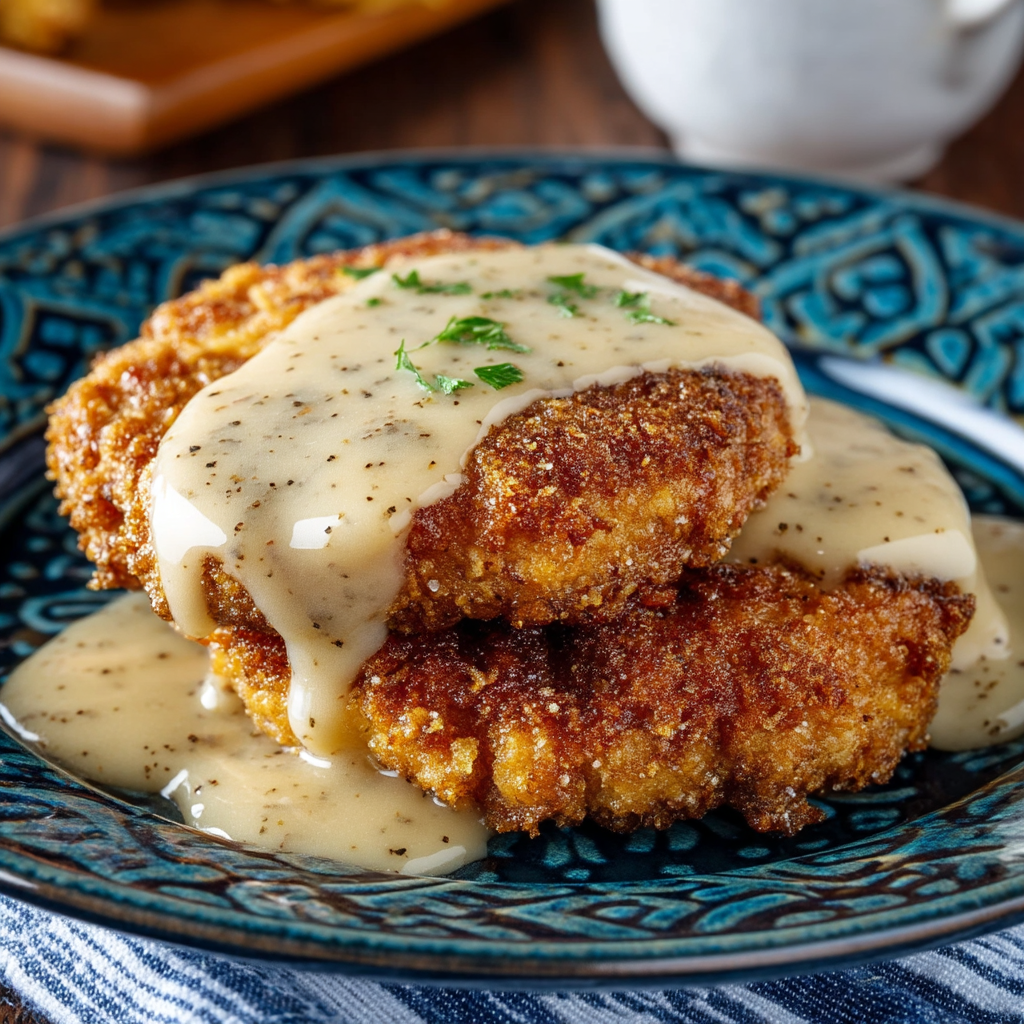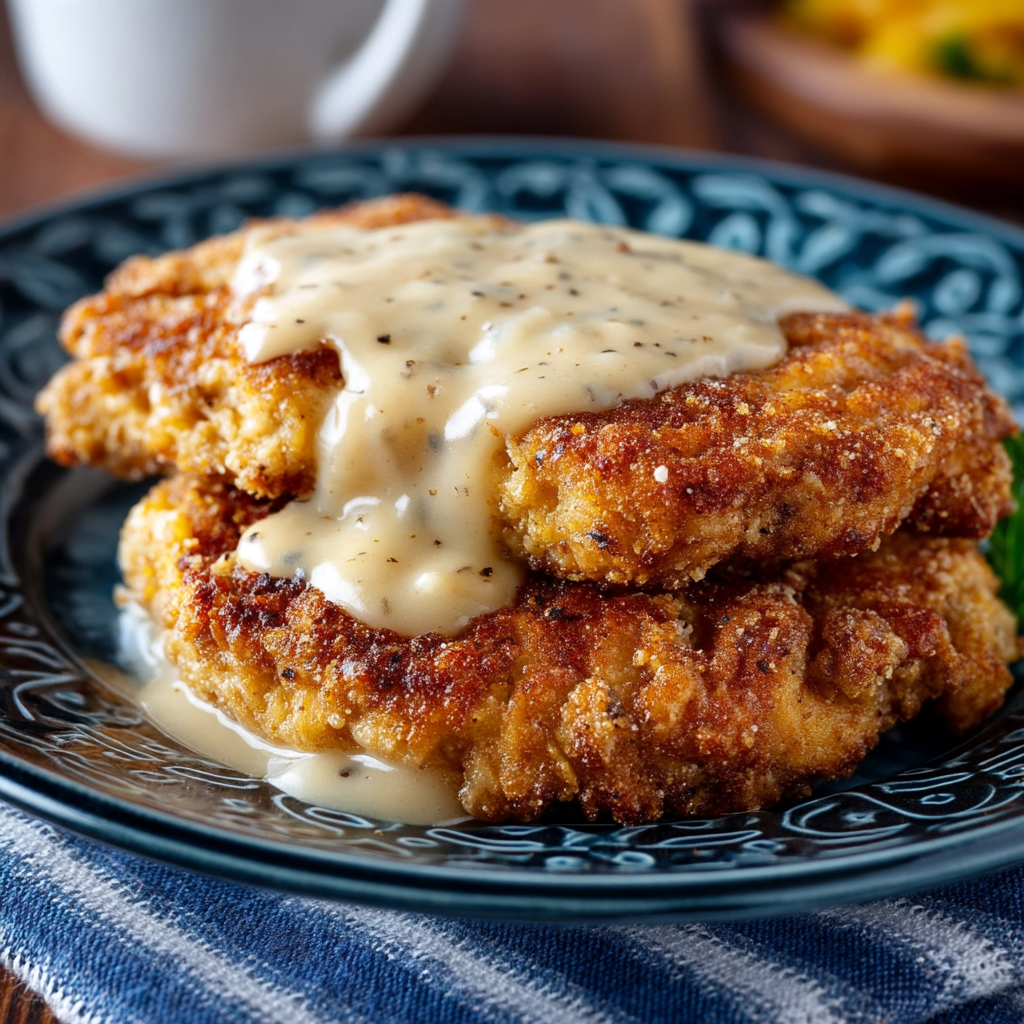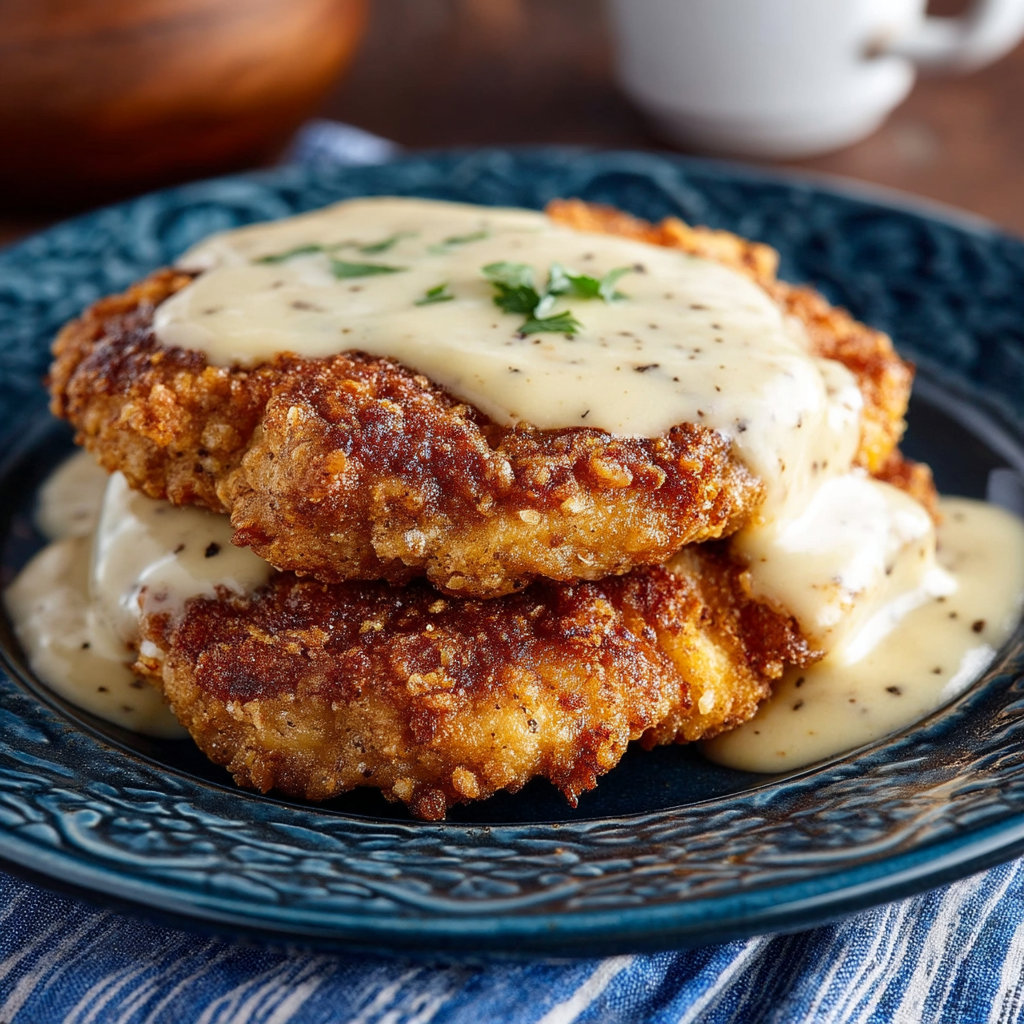1. Introduction to the Recipe
If you’re craving the ultimate Southern comfort dish, look no further than Chicken Fried Steak. This iconic recipe takes tenderized cube steaks, dredges them in seasoned flour, and fries them to a golden crisp. It’s hearty, satisfying, and made even more irresistible when smothered in a creamy, peppery gravy. Whether you grew up eating this dish or are new to it, Chicken Fried Steak is one of those meals that hits all the nostalgic, home-cooked notes.
This recipe uses buttermilk and a dash of TABASCO® Sauce to tenderize and flavor the meat while keeping it juicy. The breading is light, crisp, and seasoned just right with paprika, onion, and garlic powder. The addition of baking soda and baking powder helps ensure a flaky crust that holds up beautifully under the creamy gravy. The gravy itself is made using reserved grease from frying, whisked with flour, milk, and cream until velvety smooth.
What makes this dish special is how it combines rustic technique with elevated flavor. You get the texture of perfectly fried steak, the richness of creamy gravy, and the comfort of a meal that brings people together. If you’re new to frying or want to perfect your method, check out this helpful deep frying basics guide and this in-depth gravy troubleshooting tutorial.
Perfect for weeknight dinners, special weekend meals, or anytime you need a little extra comfort, this Chicken Fried Steak delivers with every bite.
2. Basic Recipe: Ingredients and Instructions
Print
Crispy Chicken Fried Steak with Creamy Gravy
Description
This Chicken Fried Steak is next-level—crispy, golden, and loaded with the creamiest gravy ever. You won’t find a more Southern dish out there. The only question is: breakfast or dinner? Either way, my family goes crazy for the tender steak and that addictively crunchy crust. And the gravy? It’s straight-up amazing.
Ingredients
Steak & Breading
-
4 cube steaks (about 1/3 lb each)
-
1 ½ cups all-purpose flour
-
2 teaspoons freshly ground black pepper, divided
-
2 teaspoons kosher or sea salt, divided
-
½ teaspoon smoked paprika
-
½ teaspoon onion powder
-
½ teaspoon garlic powder
-
½ teaspoon baking soda
-
½ teaspoon baking powder
-
1 ½ cups buttermilk
-
2 teaspoons TABASCO® Sauce
-
2 eggs
-
1 cup vegetable oil
Gravy
-
4 tablespoons leftover grease from frying
-
4 tablespoons all-purpose flour
-
2 to 3 cups whole milk
-
½ cup heavy whipping cream
-
Salt and black pepper to taste
Instructions
Marinate the Steaks
In a shallow bowl, whisk together buttermilk, TABASCO® Sauce, and eggs until smooth. Place cube steaks in the mixture, turning to coat. Cover and refrigerate for at least 30 minutes, or up to 4 hours for deeper flavor.
Prepare the Breading
In another bowl, mix flour, 1 teaspoon salt, 1 teaspoon pepper, paprika, onion powder, garlic powder, baking soda, and baking powder.
Bread the Steaks
Remove steaks from the marinade, letting excess drip off. Dredge each piece in the seasoned flour, pressing firmly to adhere. Place on a tray and let rest for 10–15 minutes to allow the coating to set.
Fry the Steaks
4. In a large cast iron skillet or deep pan, heat 1 cup vegetable oil over medium-high heat to about 350°F (175°C). Fry steaks in batches, 3–4 minutes per side, or until golden brown and cooked through. Don’t overcrowd the pan. Remove and drain on a wire rack or paper towels.
Make the Gravy
5. Pour off all but 4 tablespoons of the cooking grease. Over medium heat, whisk in 4 tablespoons flour. Cook 1–2 minutes, whisking constantly until light brown. Slowly pour in milk while whisking to avoid lumps. Add cream and cook until thickened. Season with remaining salt, pepper, and additional spices to taste.
Serve
6. Plate each steak and spoon generous amounts of gravy on top. Serve with mashed potatoes, biscuits, or sautéed greens.
Notes
Use cube steak for convenience—it’s already tenderized, perfect for frying.
Letting the breaded steaks rest helps the coating stay intact during frying.
Adjust gravy thickness by varying the amount of milk. Start with 2 cups, and add more as needed.
Add crushed black pepper at the end for extra bite in the gravy.
3. Advanced Techniques
Perfect Breaded Crust with Rest Time
A critical step to ensure the breading doesn’t fall off during frying is letting the steaks rest after dredging. When breaded cube steaks are allowed to sit for 10 to 15 minutes, the flour mixture absorbs some moisture and adheres better. This results in a firm, cohesive crust that won’t slide off into the oil. Resting also helps prevent sogginess, allowing the breading to puff slightly and fry evenly. If you skip this step, you may find yourself with spotty coverage or soggy coating. It’s a simple technique that ensures a professional-quality finish.
Layering Flavor in the Gravy
To take the gravy from good to unforgettable, layer flavors into the roux. Let the flour cook until it’s lightly browned—this develops nutty notes and removes the raw taste. Use whole milk and a splash of heavy cream for richness. You can also stir in a teaspoon of Dijon mustard or Worcestershire sauce for depth, or fresh cracked black pepper for boldness. Add seasonings slowly and taste as you go. A little onion powder or garlic powder can enhance the savory notes without overpowering the steak. Always season the gravy just before serving.
Using a Thermometer for Frying Accuracy
Maintaining the correct oil temperature is key for evenly fried steak. Use a thermometer to ensure your oil stays around 350°F (175°C). If it’s too hot, the breading will burn before the steak cooks. Too cold, and the steak absorbs oil and turns greasy. Between batches, allow the oil to come back to temperature before adding the next steak. A clip-on candy thermometer or infrared thermometer makes this step easy and ensures consistently perfect frying every time.
Adding Crunch with Double Dredging
For an extra thick, crispy crust, try double dredging. After the first flour coat, dip the steak back into the buttermilk-egg mixture, then dredge in flour again. This technique builds a more textured exterior that fries up crunchy and golden. Be sure to let the coated steak rest again so the second layer sets. Double dredging is especially helpful for those who like a hearty crust that stands up to generous spoonfuls of gravy.
Enhancing Texture with Baking Powder & Soda
The combination of baking powder and baking soda in the flour mix is a game changer. These leavening agents react with the buttermilk’s acidity to create air pockets in the breading, resulting in a lighter, crispier crust. Don’t skip this—even though the amounts seem small, they dramatically affect the final texture. The breading becomes flaky and tender without being heavy or doughy. It’s a technique borrowed from Southern-style fried chicken that works wonders in Chicken Fried Steak.
See more advanced recipes at cookingwhite.com

4. Storage, Shelf Life, and Maintenance Tips
Refrigerating Leftovers
If you have leftover steaks, store them in an airtight container in the refrigerator for up to 3 days. To prevent the breading from becoming soggy, place a paper towel between stacked steaks. Store gravy separately in a sealed container. When reheating, use a toaster oven or air fryer to restore crispiness to the steak. Reheat gravy gently on the stovetop with a splash of milk if it’s too thick. Avoid microwaving, as it can make the breading rubbery.
Freezing for Longer Storage
Cooked Chicken Fried Steak can be frozen for up to 2 months. First, let the steaks cool completely. Place them in a single layer on a baking sheet and freeze until solid. Then transfer to freezer-safe bags or containers, separating layers with parchment. Freeze gravy separately in small portions. To reheat, thaw steaks overnight in the fridge and warm in the oven at 375°F until hot and crisp. Heat the gravy gently in a saucepan, adding a little milk as needed to revive its creaminess.
Reheating While Preserving Texture
The best method for reheating while keeping the coating crisp is using an oven or air fryer. Preheat to 375°F and place the steak on a wire rack set over a baking sheet. Bake for 10–15 minutes until heated through and crisp. Avoid covering it with foil—it traps steam and softens the crust. Never microwave unless absolutely necessary; it makes the breading soggy. Reheat the gravy separately and add it just before serving for the best experience.
Storing Gravy Safely
Gravy should be cooled quickly after cooking and stored in a sealed container in the fridge. It lasts about 4 days when properly refrigerated. To reheat, place in a saucepan over medium-low heat and whisk gently. If it’s too thick, add milk or cream to bring it back to the desired consistency. For longer storage, freeze gravy in portions for up to 3 months. Be sure to cool it completely before freezing, and thaw overnight in the fridge before reheating.
Maintaining Crispiness in Leftover Steak
The key to keeping your leftover Chicken Fried Steak crispy is not to store it in an airtight container with the gravy. The moisture from the gravy will soften the crust. Instead, place the steaks on a wire rack inside a baking sheet, and cover loosely with foil. Reheat in the oven or air fryer at 375°F until hot and crispy again. For best results, avoid refrigerating steaks with gravy—store them separately and serve fresh.

5. Dietary Adaptations and Substitutions
Gluten-Free Version
To make this Chicken Fried Steak gluten-free, substitute the all-purpose flour with a gluten-free all-purpose flour blend. You can also use rice flour or cornstarch for the breading to maintain crispness. Be sure to check that your TABASCO® Sauce and other seasonings don’t contain gluten. For the gravy, simply use a gluten-free flour blend or cornstarch for thickening. The result is still crispy, flavorful, and safe for those with gluten sensitivities.
Dairy-Free Option
For a dairy-free version of Chicken Fried Steak, swap the buttermilk for a dairy-free alternative like almond or soy milk, and add a teaspoon of lemon juice to mimic the tanginess of buttermilk. For the gravy, use coconut milk or almond milk and substitute the heavy whipping cream with coconut cream for richness. While these substitutions alter the flavor slightly, they still deliver a satisfying and indulgent meal.
Low-Carb/ Keto Adaptation
To make Chicken Fried Steak keto-friendly, replace the flour with almond flour or a mixture of almond flour and pork rinds for a crispy coating. You can skip the baking soda and powder in the breading and focus on achieving texture through the fat content in the pork rinds. Use unsweetened almond milk in place of the buttermilk and skip the sugar, adjusting seasonings to taste. The gravy can be thickened using a small amount of xanthan gum instead of flour for a low-carb alternative.
Vegetarian Adaptation (Plant-Based Steak)
If you prefer a plant-based version, try using a vegan steak substitute such as a store-bought meatless patty or breaded tofu slices. Coat and fry them as you would with the cube steaks, making sure to adjust the seasoning and the cooking time. For the gravy, use plant-based butter and non-dairy milk for a vegan version of the creamy sauce. This provides a satisfying alternative for vegetarians or those avoiding animal products.
Low-Sodium Version
To reduce the sodium content in Chicken Fried Steak, reduce the amount of kosher salt in the breading and gravy. Use a low-sodium TABASCO® Sauce and opt for unsalted butter when making the gravy. Additionally, you can use low-sodium or homemade broth to replace some of the milk in the gravy, which helps control the overall sodium intake while still maintaining a rich flavor.

6. FAQs About the Recipe
How do I prevent the breading from falling off?
To prevent the breading from falling off, be sure to let the breaded steaks rest for 10–15 minutes before frying. This allows the flour coating to adhere better. Additionally, ensure the oil is at the right temperature—too cold, and the breading will soak up oil; too hot, and it will burn before the steak is cooked through. Finally, avoid flipping the steak too often while frying.
Can I make the gravy ahead of time?
Yes, you can make the gravy ahead of time. Simply cook and store it in the fridge for up to 3 days. When you’re ready to serve, reheat the gravy over low heat, adding a little more milk if necessary. If you want to make the gravy the day of, prepare it while the steaks are frying to serve it hot and fresh.
Why is my steak not crispy?
If your Chicken Fried Steak isn’t crispy, it could be because the oil wasn’t hot enough, or you didn’t let the breading set before frying. To ensure crispiness, heat the oil to around 350°F (175°C), and don’t overcrowd the pan. Additionally, allowing the breaded steak to rest before frying helps achieve that perfect crunch. Make sure to drain the steaks properly on a wire rack to prevent sogginess.
How do I know when the steak is fully cooked?
For the juiciest steak, cook it until the internal temperature reaches 145°F (63°C) and the breading is golden and crispy. Cube steaks are typically thin and cook quickly, but using a meat thermometer can ensure that you don’t overcook or undercook them. For extra tenderness, you can also pound the steaks before frying to ensure even cooking.
Can I substitute the cube steaks with another cut of meat?
Cube steak is the traditional cut for Chicken Fried Steak because it is tenderized, making it perfect for frying. However, if you don’t have cube steaks, you can use sirloin or round steak, but make sure to tenderize the meat with a meat mallet to achieve the same tenderness. You can also use chicken breast for a “chicken-fried” version if preferred.

7. Conclusion & Final Thoughts
There’s nothing quite like a plate of crispy Chicken Fried Steak smothered in creamy, peppery gravy. This dish is a staple of Southern comfort food that brings people together over hearty meals, warm flavors, and the joy of shared moments. It’s perfect for weekend dinners, holiday feasts, or any time you need a comforting meal that fills you up.
From the crispy breading to the rich, velvety gravy, every bite of this dish is a delightful mix of textures and flavors. The best part? It’s adaptable to different dietary needs, from gluten-free to keto-friendly versions, making it accessible for all. Whether you’re frying for a crowd or cooking just for yourself, Chicken Fried Steak never fails to impress.
It may take a little time and technique, but with the right approach, you’ll be rewarded with a dish that’s full of flavor and nostalgia. Plus, leftovers are just as delicious the next day, making this an excellent choice for meal prep. So go ahead, get frying, and enjoy one of the most satisfying comfort meals around!
